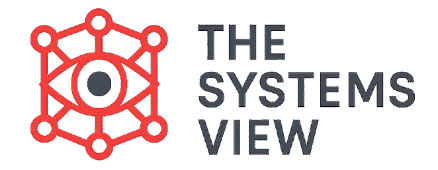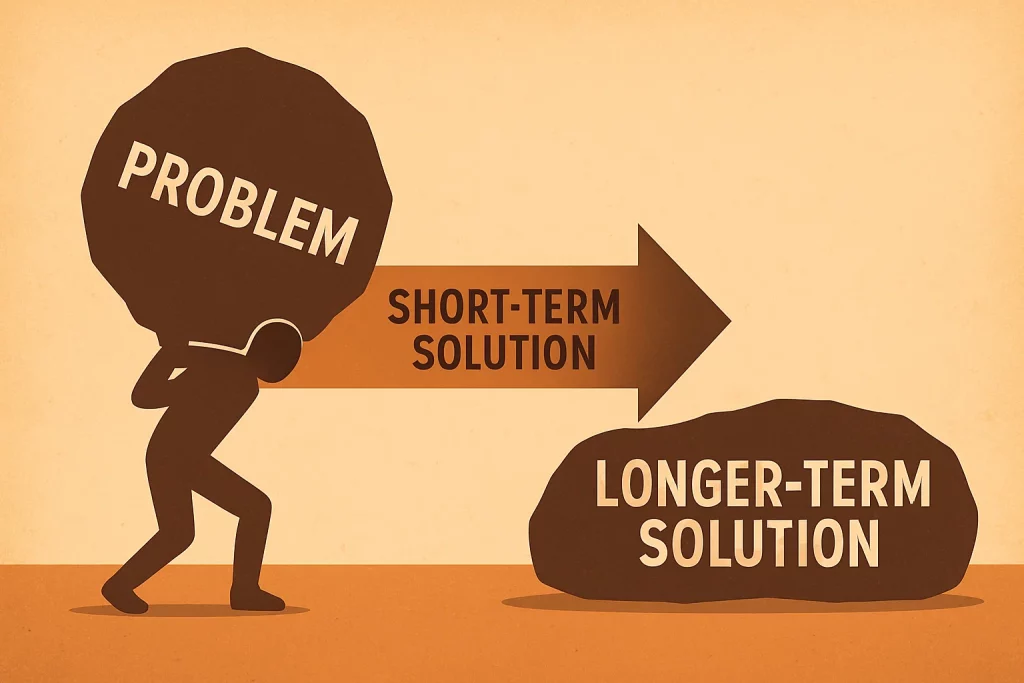In our last article, we learned about “Fixes That Fail” The second systems archetype, Shifting the Burden, is a similar but deeper pattern. It happens when you use a quick, easy fix to solve a problem, but that fix only hides the real, deeper issue. Over time, you become more and more dependent on the quick fix, while the original problem gets worse.
Imagine your car is making a strange noise. Instead of taking it to a mechanic to find the real problem, you just turn up the radio to hide the sound. The noise is gone for a while, but the real problem with the engine is still there, getting worse. Eventually, the engine will fail completely. This is the core idea of “Shifting the Burden.”
What is the “Shifting the Burden” Archetype?
This archetype is a repeating cycle where a problem is not solved but instead is simply pushed aside. The key parts of this pattern are:
- The Problem Symptom: A problem appears that needs to be solved (e.g., a team is not meeting its deadlines).
- The Symptomatic Solution: A quick, easy fix is applied. This solution gives fast relief and makes the problem seem to go away (e.g., hiring a consultant to come in and do the work for the team).
- The Fundamental Solution: This is the real, long-term solution that addresses the root cause of the problem (e.g., giving the team proper training so they can do the work themselves). This solution is often harder and takes more time.
- The Side Effect: The quick, symptomatic solution creates a negative side effect. It makes it harder to use the fundamental solution. For example, the team might become dependent on the consultant and never learn to do the work themselves.
This pattern is a trap because the quick fix gives immediate relief, which makes it very tempting to use. Meanwhile, the real problem is slowly getting worse and harder to solve.
Important: The core lesson of “Shifting the Burden” is that the quick fix often makes the real solution harder to achieve. The more you rely on the easy way out, the more you weaken your ability to solve the problem for good.
A Common Example: Relying on Overtime
A great example of this archetype is an organization that relies on overtime to meet deadlines.
- Problem Symptom: The company has too much work and is not meeting its deadlines.
- Symptomatic Solution: The company asks employees to work overtime. This quickly solves the immediate problem of meeting the deadline.
- Fundamental Solution: The real solution would be to hire more people, improve the work process, or say no to some projects. These solutions take more time and money.
- Side Effect: The overtime solution has a negative side effect. Employees get tired and burnt out. This makes them less productive and less motivated, and the work quality may drop. The underlying problem of having too much work gets worse because the team is less effective. The company then has to use more overtime, and the cycle continues.
The Practice Example from the Ebook: The Manager Who Jumps In
The ebook provides a great example of a manager who constantly “jumps in” to solve problems for their team.
- Problem Symptom: The team is struggling to solve a problem.
- Symptomatic Solution: The manager, who is an expert, steps in and solves the problem for them. The problem is fixed, and the project stays on schedule.
- Fundamental Solution: The real solution is to let the team struggle a bit, coach them, and help them learn to solve problems on their own. This would build their skills over time.
- Side Effect: Because the manager always jumps in, the team never learns how to solve problems on their own. They become dependent on the manager. This makes the manager even busier and creates a bigger problem for the company in the long run.
How to Find a Lasting Solution
To break this cycle, you must stop using the quick fix and focus on the fundamental solution.
- See the Side Effect: First, you have to recognize that the quick fix is causing a problem. Ask: “Is this solution making us weaker in the long run?”
- Focus on the Fundamental Solution: Stop all efforts on the quick fix and shift your attention to the long-term solution. This might be hard at first, as the problem will get worse before it gets better.
- Build a Stronger System: Invest time and money in the real solution. For the overtime example, this means hiring new people, improving processes, and managing projects better.
- Manage the Problem While You Fix It: You may still need to use some quick fixes while you work on the real solution, but your main focus should always be on the long-term fix.
Conclusion
The “Shifting the Burden” archetype is a powerful reminder that the easiest solution is often not the best one. By using quick fixes, we create a cycle of dependency and weaken our ability to solve the real problem. By learning to see this pattern, we can resist the temptation of the easy way out and invest our energy in building lasting, fundamental solutions. This is the only way to truly solve a problem and create a stronger system.



